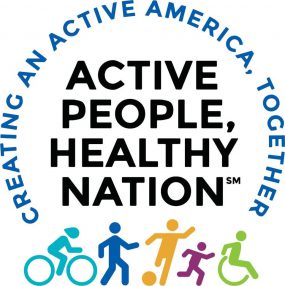Equitable and Inclusive Access
Equitable and inclusive access to safe places for physical activity is the foundation of all Active People, Healthy NationSM strategies. Every Active People, Healthy Nation strategy can be designed to support the goal of equitable and inclusive access to physical activity for all people regardless of age, race, ethnicity, education, socioeconomic status, disability status, sexual orientation, and geographic location.1
Racial and ethnic groups have unequal rates of physical activity.2 These disparities exist in part because many people live in neighborhoods with few safe spaces or other social or environmental supports to promote physical activity.3-7 This lack of access to opportunities to be active can be the result of historical disinvestment and persistent housing, transportation, urban planning, and land use policies at federal, state, and local levels—policies designed in part to segregate cities and communities by race and income.7-10
Even places with safe access to physical activity, some potential users may be left out. For example, recreation areas may not be designed for older adults or people with disabilities, and this can contribute to disparities in physical activity within these populations.11-13
People have more than one social identity, such as older age and ability status, race and gender, income level and religious affiliation. These intersecting social identities can change how people understand and live in their environment.14-15 In addition to physical barriers, these intersecting identities and historical contexts may interact with environments to influence feelings of safety, belonging, and inclusion.15 Not feeling safe or comfortable in public spaces may reduce opportunities to be physically active.16-18
Prioritizing Health Equity Can Improve and Expand Access to Safe and Convenient Opportunities for Physical Activity for People Most at Risk of Being Inactive
A commitment to equitable health outcomes calls for understanding, communicating, and addressing the factors that may prevent people or groups from getting physical activity. Engaging with people, groups, and organizations that experience inequities and disparities can improve understanding of the reasons for those experiences and gaps in efforts to change them.19, 21
Community engagement can include consulting with people from communities of focus, working with partners and organizations in coalitions that serve those communities, or both.20-21 The power to choose the best course of action for improving access to safe places for physical activity should be shared among those affected by decisions. Diverse input can help communities make better-informed decisions.19-20 For communities where health and safety have been undermined by historic disinvestment, these decisions may include prioritizing stability and neighborhood strengths while working to improve conditions for their residents.
Strategies for Improving Equitable Access to Safe Areas for Physical Activity
CDC’s Practitioner’s Guide for Advancing Health Equity provides concrete strategies—informed by evidence and practitioner experience across the nation—to incorporate health equity into foundational skills and practices in public health.21 It also includes specific strategies to achieve equitable and inclusive access to safe and convenient opportunities for physical activity. Broad health equity strategies include community engagement, building organizational capacity, and developing partnerships and coalitions. Below are some community examples of how health equity strategies were incorporated into physical activity strategies to increase equitable and inclusive access to safe places for physical activity.
- Safe and Accessible Streets for All Users [PDF-1.22MB]
Strategies and success stories on designing streets to improve access for everyone. - Trails and Pathways to Enhance Recreation and Active Transportation [PDF-2MB]
Steps to prioritize health equity in implementing trails as a venue for physical activity and active transportation. - Neighborhood Development that Connects Community Resources to Transit [PDF-2.6MB]
Examples of connecting physical activity infrastructure to transit and equitable community development to promote active transportation. - Joint Use Agreements [PDF-1.36MB](also referred to as shared use)
Information on how joint (or shared) use agreements can increase access to safe places for physical activity. - Preventing Violence [PDF-726KB]
Health equity-focused strategies to reduce and prevent community violence to promote physical activity and prevent chronic disease. - Physical Activity Opportunities in School and Youth Programs [PDF-945KB]
Information on expanding physical activity opportunities for children and youth in educational settings.
Success Stories
These groups are prioritizing health equity as they work to increase physical activity in their communities:
- Park Updates Promote Physical Activity for Tribal Nation
The Menominee Nation updated a local park with culturally relevant renovations to promote park use and physical activity for tribal nation - An Equitable Parks Plan Driven by Data
The use of data in New York City to improve access to parks and green spaces in the communities that need it most. - Utah Communities Adopt Plans to Improve Spaces for Residents to Be More Active
Cross-sector collaboration among transportation and public health organizations to create safe, accessible trails for walking and biking. - Complete Streets Help Kansas Communities Build Safe Spaces for Physical Activity
Collaboration between Kansas State Department of Health and community organizations to promote Complete Streets and activity-friendly planning.
- Health Equity Resources
This web page offers links to CDC and external resources to help communities, programs, and initiatives work to remove barriers to health and achieve health equity. - Using a Health Equity Lens
Communication resources for equity-centered and inclusive health communication. - Increasing Physical Activity Among Adults with Disabilities
This web page provides resources for doctors and health professionals to promote physical activity among patients with disabilities. - Small Town and Rural Multimodal Networks [PDF-39.9MB]
This Department of Transportation resource can help rural communities build and improve activity-friendly infrastructure.

